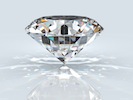Education is key to buying diamonds
This is your guide for how to purchase high quality diamonds. Understanding the 4 C's - cut, clarity, color and carat of a diamond are essential to getting the best diamond quality for an affordable price.
1. Cut : The cut of a diamond determines its brilliance. Put simply, the better a diamond is cut, the more sparkle it will have. The cut of a diamond has the greatest influence on the image of the diamond. A well-cut diamond will appear very brilliant and fiery, while more poorly cut stones can appear dark and lifeless, regardless of color or clarity. Not only do well-cut diamonds appear more brilliant, they can also appear larger than other stones of the same carat weight. A well cut stone has both increased brilliance as well as increased diameter.

Clearly, the cut of the diamond determines its shape, there are several important shapes that diamonds will be classified in.
Round : This is the most popular cut. It is the most common in earrings, necklaces, and, of course, engagement rings. There are fifty-eight facets in a Round Brilliant Cut. Of course, Round cuts are the most expensive of the diamond cuts. It is very possible to keep more weight from an unpolished diamond if it is cut into a shape other than a Round.
View our fine round diamond selection.

Princess : Princess cut diamond is usually more square-shaped than rectangular. It is one of the most popular cuts used in diamond jewelry, especially for engagement rings. In GIA grading reports, a princess cut diamond is called a rectangular modified brilliant, or a square brilliant. It can have fifty facets, or fifty-eight facets.
View our fine princess diamond selection.

Emerald : The Emerald cut diamond commonly has fifty-eight facets; it is usually referred to as a step cut because it has rows of facets. An Emerald cut diamond has a subtle, understated, and classic look; it is less flashy than brilliant cut diamonds. Rectangular shaped is the most popular shape of an Emerald cut. A higher color and clarity is recommended when purchasing an Emerald cut diamond, because they are more likely to become more noticeable at a lower grade.
View our fine emerald diamond selection.

Asscher : Similar to an emerald cut, an Asscher cut is also referred to as a step cut; the Asscher cut is more of a square with deeply cut corners, making the final shape more of an octagon. A smaller table, a larger step facet, deeper pavilion, and a higher crown than an Emerald cut characterize the Asscher cut. Because of these characteristics, the Asscher cut has more fire and light than the Emerald cut. We recommend that any Asscher stone have at least VS2 clarity and H color.
View our fine asscher diamond selection.

Heart : A brilliant cut diamond, usually contains fifty-nine facets. Many Heart cut stones are purchased as single diamonds for necklaces in half-carat sizes or more. They are popular as matched pairs for stud earrings, or side-accent stones for diamond rings or earrings. When purchasing heart-shaped stones together, it is very important to look for perfectly symmetrical stones. The top arches should be of even height and breadth. The heart shape should be neither too flat, nor overly deep. To keep a good balance between the brilliance of the diamond and the bigger/smaller look of the stone. A heart-shaped stone should have at least I color and SI2 clarity.
View our fine heart diamond selection.

Cushion : Previously known as the Old Mine Cut, developed in the late 1800s, a Cushion cut can be square, to rectangular, to everything in between. Cushion cuts have fifty-eight brilliant-style facets and rounded corner. A classic Cushion cut got its cut from its pillow-like shape, which tends to have a ratio in the 1.1-1.2 range. The ratio generally depends on the customer’s personal preference. A modified cushion often has the exceptional sparkle look of a well-cut Radiant cut diamond. A Cushion cut should have at least I color and SI2 clarity with a length-to-width-ratio of 1.1-1.2. If you are looking for a fancy color diamond, the cushion cut is a good choice, because it displays the color evenly throughout the stone.
View our fine cushion diamond selection.

Marquise : A Marquise is an elongated, fancy-shaped diamond, pointed on both ends. The Marquise has a very large surface area for its carat weight, so if you’re looking for a big look at a cost-effective price, this is an excellent choice. The Marquise diamond should have at lease I color and SI2 clarity.
View our fine marquise diamond selection.

Oval : Known technically as the "oval modified brilliant", the oval is most frequently cut in a standard fifty-eight facet brilliant pattern, but can vary with a number of pavilion main facets, having four, six, or eight. Oval prices are relatively high because they are very much sought after. They are popular for center stones in engagement rings and also three-stone rings which are popularly used as anniversary gifts. Oval shapes must have even, well-rounded ends with an optimal length-to-width-ratio of 1.33-1.35. Oval-shaped diamonds contain a bigger surface area than round diamonds with the same carat weight, which make them a good choice for purchasers looking for the same brilliance as a round diamond, and a bigger look, for the price. Oval diamonds should have at least I color and SI1 clarity.
View our fine oval diamond selection.

Pear : Technically, the pear is referred to as the "pear-shaped modified brilliant" because it is a modified version of the traditional round brilliant. It is a blend of the round and marquise brilliant cuts and generally has the 58 facet brilliant pattern, but can be cut with various numbers of pavilion mains of 8, 7, 6, or 4 facets. The teardrop shape encompasses a round or oval shape on half the facet pattern while the other half resembles a marquise. Pear shaped diamonds are used for engagement rings, layouts for pendants for necklaces, dangles in earrings, and integral parts of custom designs. We commonly seek pear shaped diamonds with a depth 57-65.4% and table 52-64%. We recommend at least I color and SI1 clarity for pear shaped diamonds.
View our fine pear diamond selection.

Radiant : The radiant cut is the rectangular or square modified brilliant. While some radiant cut diamonds have 70 facets, the most common facet pattern has 62 facets. The trimmed corners help to minimize chipping. The radiant cut diamond is the first rectangular cut to have a complete brilliant facet pattern applied to both the crown and pavilion. This presents a more shiny and brilliant diamond than the simple emerald cut. We recommend radiant cut diamonds with depth 58-69% and table 58-69%. We advise at least I color and SI1 clarity for radiant cut diamonds. Radiant cuts are especially popular for fancy colored diamonds because shape, proportioning and facet arrangement strengthen the color.
View our fine radiant diamond selection.

Trillion : The trillion cut diamond was originally used as side stones to a larger diamond on engagement rings, but now it is commonly used as a center stone. The trillion shape is a brilliant cut, meaning that it catches light well, projecting its sparkly image. The exact design of trillion cut diamonds depends on two things: the skill and preference of the cutter, and the natural features of the stone. The diamond can be a triangle with pointed corners, or more rounded, with 25 facets on the crown, and 19 facets on the pavilion. The crown is the upper part of the diamond above the girdle. The girdle is the narrow rim around the diamond.
View our fine trillion diamond selection.

2. Clarity : Clarity is a measure of the tiny imperfections that appear in all diamonds. Clarity simply refers to the minute, natural imperfections that occur in most diamonds. Gemologists refer to these imperfections by a variety of technical names, including blemishes and inclusions.

Diamond Clarity
| FL, IF | Flawless, Internally Flawless: No internal or external imperfections. Internally Flawless: No internal imperfections. Very rare. | |
|---|---|---|
| VVS1, VVS2 | Very, Very Slightly Included: Very difficult to see imperfections under 10x magnification. An excellent quality diamond. | |
| VS1, VS2 | Very Slightly Included: Imperfections are not typically visible to the unaided eye. Strongly Recommended | |
| SI1, SI2 | Slightly Included: Imperfections are visible under 10x magnification, and may be visible with the unaided eye. A good diamond value. Strongly Recommended | |
| SI3, I1 | This grade of diamonds will have minor inclusions that may be visible to the unaided eye. Low budget for a big size diamond | |
| I2, I3 | Imperfections visible to the naked eye. | |
3. Color : Color refers to how white the diamond appears to be. A diamond’s color grade is based on its lack of color. D is the highest color grade possible, and Z is the lowest. Color projects itself in a diamond as a whitish yellow. The less color a diamond has, the higher its color grade will be. Color is considered the second most important feature to a diamond because the human eye is drawn to sense a diamonds sparkle and color at first glance.
- D - Absolutely colorless. The highest color grade. Extremely rare.
- F-E - Colorless. Very little traces of color can be found.
- H-G - Near-colorless. Color difficult to detect unless compared side-by-side against diamonds of better grades.
- I-K - Near colorless.
- Z-N - Noticeable color.
4. Carat : Contrary to popular belief, carats do not only represent the size In describing diamond weight, you often hear the term points used. For example, you might hear that a diamond is 84 points. This has the same meaning as .84 carats, because there are 100 points to a carat. Thus, .50 carats would be the same as 1/2 carat or 50 points, 1.50 carats would be the same as 1 carat and 50 points or one and one half carats. In making your purchasing decision, it is important to realize that a 2 carat diamond will not look double the size of a 1 carat diamond. Because a diamond is three dimensional, the carat weight is dependent on both the diameter and depth.



